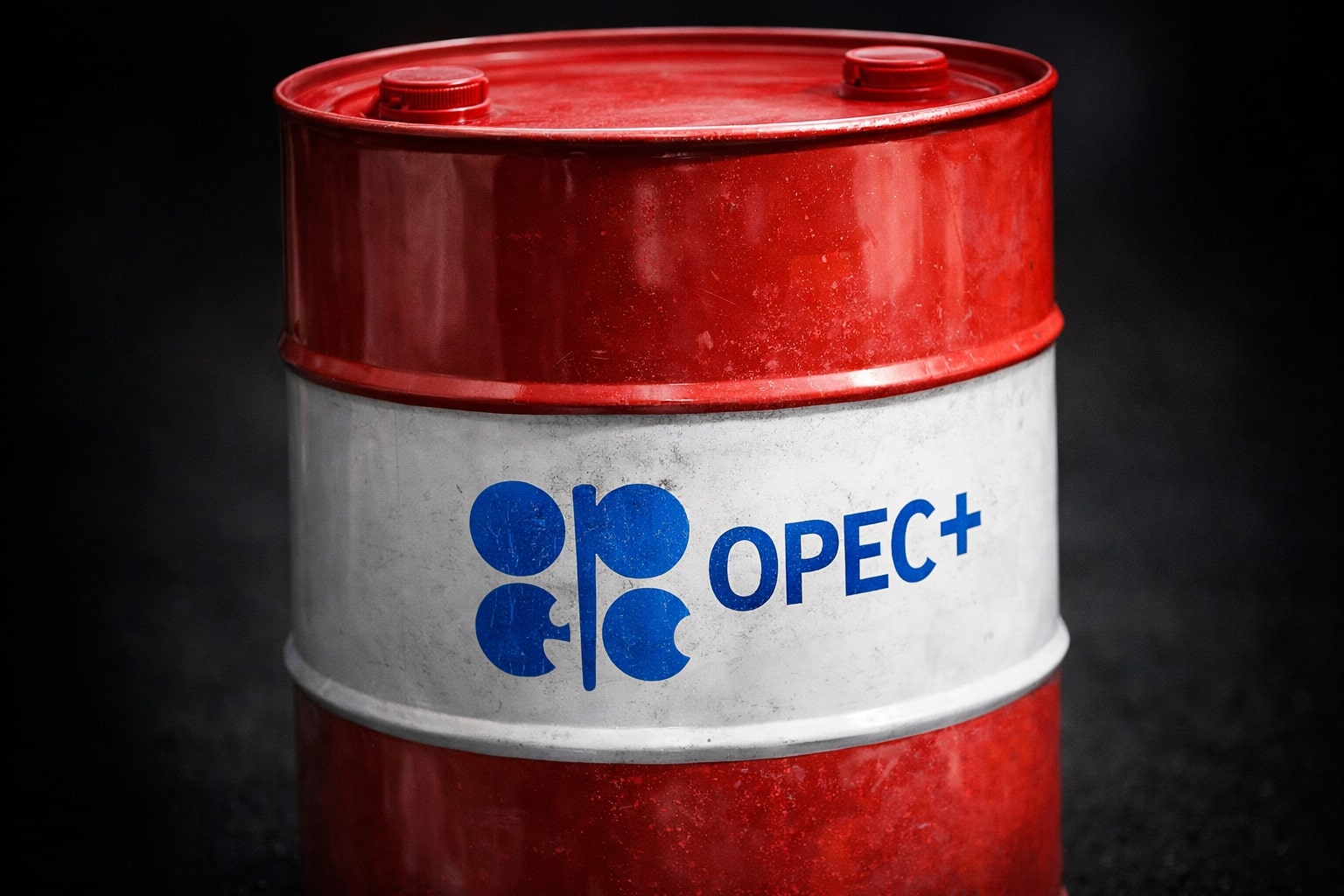
Oil Prices Steady With WTI at $63.98 and Brent at $68.12 as Record U.S. Output Meets OPEC+ Supply Shifts
U.S. production hits 13.58M bpd, inventories fall 2.4M barrels, tariffs on India weigh on demand while OPEC+ prepares to unwind 2.2M bpd of cuts | That's TradingNEWS
WTI (CL=F) and Brent (BZ=F) Under Pressure as Tariffs, Oversupply, and Geopolitics Collide
Oil markets are locked in a volatile stretch with WTI crude (CL=F) trading near $63.98 per barrel, down 0.96% on the session, while Brent (BZ=F) holds around $68.12, off 0.73%. Both benchmarks remain trapped in a fragile range as oversupply collides with political shocks and trade disruptions. U.S. President Trump’s decision to double tariffs on Indian imports to 50% has rattled demand expectations, with India’s $87 billion export pipeline to the U.S. under threat. Brent slipped to $67.44 after the announcement, and WTI fell to $63.89, underscoring the fragility of global demand as the summer driving season ends.
Global Supply Flows Disrupted but U.S. Output Surges to New Record
The EIA confirmed that U.S. production hit a record 13.58 million barrels per day in June, well above weekly estimates, cementing America’s role as the swing producer. Growth came largely from New Mexico, up 40,000 barrels per day to 2.24 million, and the Gulf of Mexico, which added 67,000 barrels daily. Texas output held steady at 5.72 million barrels, while California slid 14% year-over-year. Despite a shrinking rig count, efficiency gains and drilled-but-uncompleted wells are allowing U.S. producers to maintain momentum. Exports topped 4 million bpd in 2024, though refining capacity continues to shrink, creating bottlenecks. The EIA projects only marginal growth in 2025 before a slowdown in 2026 if crude averages remain in the $60s.
OPEC+ Strategy, Russian Exports, and Saudi Pricing Moves Shape Market
OPEC+ policy remains central. The cartel is preparing to unwind 2.2 million bpd of cuts in October, even as Saudi Arabia signals it will trim October prices to Asia by $0.50–$0.70 per barrel. Russia is struggling with pipeline outages at Ust-Luga, halving throughput to 350,000 bpd after drone strikes damaged pumping stations. Meanwhile, Russia extended its gasoline export ban until October 31 in an attempt to curb domestic fuel spikes, tightening refined product flows globally. The OPEC basket price sits at $69.65, virtually flat, but volatility in member exports—from Nigeria to Venezuela—continues to weigh on sentiment.
Demand Concerns Meet Macro Tailwinds
While trade tariffs and oversupply cap rallies, U.S. economic resilience offers support. The economy grew 3.3% QoQ in Q2, ahead of expectations, bolstering consumption outlooks in the world’s largest oil market. Inventories confirm strength: U.S. crude stockpiles fell 2.4 million barrels to 418.3 million, well beyond the 1.7 million draw expected. Gasoline inventories also slipped by 1.2 million barrels, pointing to ongoing demand. Traders are now pricing in an 85% chance of a Fed rate cut in September, with another reduction likely by year-end. Lower rates would underpin fuel-intensive sectors, partially offsetting weaker Asian demand as refiners head into seasonal maintenance.
Geopolitical Premium Rebuilds Amid Russia-Ukraine Conflict
Drone warfare continues to disrupt Russian energy infrastructure. Ukrainian strikes hit two refineries near Moscow this week, while Russia retaliated with heavy bombardments against Kyiv. Deliveries through the Druzhba pipeline to Hungary and Slovakia resumed after brief outages, but at reduced capacity. Russia’s Baltic port volumes remain capped, creating knock-on effects for European supply. Meanwhile, U.S. diplomacy with both Moscow and Kyiv has yielded optics but no breakthroughs. Markets are repricing a geopolitical premium as risks to flows from Russia mount, even if Brent’s reaction has been muted to date.
Regional Dynamics: India, Guyana, and Latin America
India has shifted its sourcing strategy in response to tariffs, raising purchases of U.S. crude, with refiners moving quickly to secure favorable pricing. At the same time, Guyana’s offshore boom is reshaping South America’s energy map. ExxonMobil’s Stabroek block has scaled production to 900,000 bpd, with breakevens near $30 per barrel, ensuring profitability even at current prices. Guyana’s elections now hinge on how revenues are shared, with opposition parties pushing for tougher terms with Exxon. In Mexico, the Dos Bocas refinery has gone offline due to power outages, complicating President López Obrador’s energy strategy just as the plant approached half-capacity. Petrobras (NYSE:PBR) continues to move closer to Amazon exploration, with environmental approval still contested, highlighting the broader tension between growth and green politics in Latin America.
Technical Levels Define Short-Term Trade
For WTI (CL=F), $65 remains the critical pivot. A sustained move above the 50-day EMA opens a channel toward $70, while breakdowns risk sliding back toward $62. Brent (BZ=F) faces parallel pressure, with $67 as immediate support and resistance at $69. Breaks above $69 would target $72, while failure opens the door to $62.50. Goldman Sachs projects Brent could average $63.57 in Q4 2025, while WTI averages just above $60, highlighting the risk of oversupply. Current positioning suggests sideways trade unless a catalyst—tariffs, OPEC+ decisions, or escalations in Ukraine—shifts balances sharply.
Verdict on Oil Markets
Crude benchmarks are navigating a tightrope between record U.S. output at 13.58 million bpd, weaker Asian demand, and rising geopolitical risk. Inventories and Fed policy lean bullish, but supply growth and tariffs cap rallies. Based on current fundamentals, oil is a Hold, with WTI likely range-bound between $62–$70 and Brent between $65–$72 through September, unless geopolitical shocks push prices higher.
That's TradingNEWS
Read More
-
GPIX ETF Climbs to $52.54 as 8% Yield Turns S&P 500 Volatility Into Income
02.01.2026 · TradingNEWS ArchiveStocks
-
XRP ETF Rally: XRPI $11.54, XRPR $16.35 And XRP-USD At $1.99 Aim For A $5–$8 Cycle
02.01.2026 · TradingNEWS ArchiveCrypto
-
Natural Gas Price Forecast: NG=F Tests $3.50–$3.60 Floor Before LNG Wave
02.01.2026 · TradingNEWS ArchiveCommodities
-
USD/JPY Price Forecast - USDJPY=X Holds Near 157 as BoJ Caution and Fed Cut Bets Drive the Move
02.01.2026 · TradingNEWS ArchiveForex



















